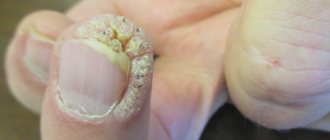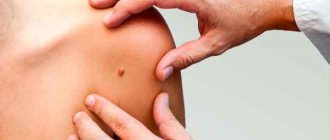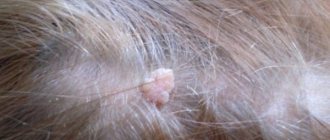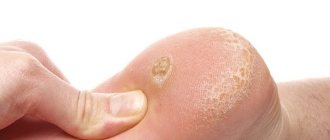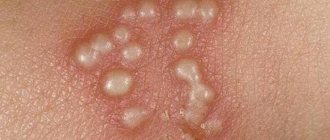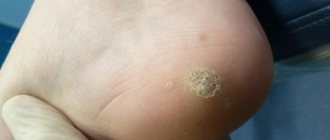Filiform warts (acrochords) are small neoplasms on the skin of a round or elongated shape. They give their carriers unpleasant sensations of a physical and psycho-emotional nature. In particular, when such neoplasms are located in conspicuous places. These growths primarily damage the skin of the cervical region and eyelids. Observed in adults after 35 years. The formation of filamentous warts is uncharacteristic for a child.
A filiform wart is an oblong elastic neoplasm measuring 0.5-0.6 cm. It appears on the skin of the face and cervical region, under the mammary glands and under the armpits. Acrochords are caused by the papilloma virus and are prone to spreading to nearby areas of the body. Diagnostic measures include dermatological examination and dermatoscopy. In treatment together with the elimination of papillomas using hardware methods, conservative therapy for HPV is recommended.
Reasons for appearance
Many people are carriers of one or another type of neoplasm, since almost everyone is infected with some type of HPV. This is due to the various routes of infection characteristic of viral elements. These include:
- Contact. Infection occurs through direct contact with an HPV carrier. The virus enters the body through minor skin lesions, during handshakes, and when sharing utensils with an infected person.
- Infection due to physical contact with a surface containing the virus.
- Self-infection during the process of internal migration of the virus from damaged areas of the skin to healthy ones.
It should be noted that not in all cases the virus that is in the human body multiplies, provoking the formation of filamentous warts. A healthy immune system will become a natural obstacle to the activity of the virus. Often the patient himself provokes HPV to this. There are known reasons that activate the development of HPV:
- weak immunity,
- stressful situations,
- malfunction of the central nervous system,
- inflammatory process in the ovaries,
- gastrointestinal diseases,
- changes that are associated with age.
Removal
Since the growths are benign, there is no need to treat them for medical reasons. But some patients seek to get rid of them, especially if they cause discomfort or for cosmetic reasons.
On this topic
- Papillomas
All about laser removal of papillomas
- Inna Viktorovna Zhikhoreva
- September 25, 2021
If removal is desired or warranted, a dermatologist, general practitioner, or similarly trained specialist may have several options to choose from:
- Cauterization using a laser. The procedure is quite painful and, therefore, local anesthesia is used. If it is necessary to remove a cluster of acrochordons, then it is performed in a stationary setting. Carries a risk of damage to surrounding tissue.
- Cryotherapy associated with the application of liquid nitrogen to formations. Once frozen, they will fall off on their own within a few days. The procedure is painful and carries the risk of scarring. Skin discoloration is also possible.
- Surgical removal is an expensive treatment option that involves circumcision and its inherent complications (bleeding and susceptibility to infection of the wound area). There may be a scar and a change in skin color.
- Acidic solutions are applied to the formations and they disappear within a few days. But like all the procedures listed above, it is also associated with pain and is dangerous for scarring and discoloration of the skin.
- Ligation of the acrochordon with a dense thread in order to cut off the blood supply. It dries out and falls off after a while. But the method is not always possible to use depending on the location of the formation. Moreover, its effectiveness may be questioned.
First signs
Filiform warts, papillomas or acrochords are minor neoplasms of viral origin.
Initial symptoms:
- Their appearance begins with a small yellow tubercle.
- Next, it transforms into an elongated growth on a stalk.
- Papillomas have an elastic consistency.
- The color is identical to the skin, but in certain situations it can be dark brown.
These growths prefer places with high humidity, for example, the armpits.
Diagnostic methods for recognizing filiform warts
Diagnosis begins at the first meeting with a dermatologist by visual examination of the wart
Diagnosis begins at the first meeting with a dermatologist by visually examining the wart. Next, it is necessary to use dermatoscopy, which is carried out using a special microscope to enlarge the acrochord. During the examination, blood clots and angiopathy are detected in the blood vessels.
This information confirms the presence of viral genesis in the appearance of warts. In addition, to confirm infection, PCR should be used, which can detect the papilloma virus in human blood. If these methods could not confirm the diagnosis, then you need to resort to a biopsy with a histological review of the acrochord.
Locations
When choosing a location, growths are quite selective: they appear where the skin is thinner, in the folds of the skin and in places of high humidity.
Often filamentous warts appear:
- in the facial area (affect the eyelids, frontal part, near the nose),
- in the groin area,
- cervical region,
- in the armpits,
- in women under the mammary glands.
In places with a thicker layer of skin, neoplasms are not observed.
Folk recipes
Treatment of acrochords with alternative medicine methods is carried out using the healing properties of plants. Therapy with folk remedies should be used as a complement to classical methods of eliminating warts.
Celandine is a powerful remedy for combating all types of skin growths. Freshly squeezed plant juice is applied to the papilloma several times a day. This therapy should be continued until the wart falls off.
Garlic-based compresses will help treat papillomas. Several cloves must be finely chopped or grated until a paste is obtained. Add melted pork fat or Vaseline to the resulting mass in a 1:1 ratio.
Mix the ingredients thoroughly. Place the healing pulp on a cotton pad and secure it to the problem area with a band-aid. This procedure must be done at night every day until complete healing.
In the autumn-winter period, when fresh vegetation is not available, rowan berries will help. They make a paste for compresses. All steps are performed in the same way as in the previous recipe. This treatment is absolutely safe for the skin.
Garden iris helps eliminate warts. You should crush the leaf of the plant in your hands so that the juice comes out, apply it to the problem area and secure it with a band-aid. This compress should be done daily.
Risk factors
Over time, the number of filamentous warts increases. Neoplasms are observed in almost half of the population after 50 years.
This is caused by the following factors:
- deterioration of the immune system,
- HIV infection,
- infectious lesion,
- metabolic failure,
- oncology,
- chronic diseases,
- unbalanced diet,
- constant trips to the solarium,
- old age,
- stressful situations,
- ultraviolet irradiation.
Treatment methods
In almost all cases, filamentous papillomas are not treated on their own (as, for example, juvenile or vulgar growths in childhood can disappear on their own). They need therapy. Moreover, when these neoplasms begin to be injured. Therapeutic measures involve the use of various methods.
Hardware removal
Elimination of filamentous warts is carried out using modern methods or through surgery. The most common methods:
- Laser removal. A modern and harmless way to eliminate various growths. The method is based on burning out the papilloma with a laser, after which a crust will remain, and after 3 days it will fall off. The operation requires local anesthesia; the laser action itself lasts no more than 1 minute. The downside will be the high price.
- Using Surgitron. Also a common technique is based on burning out warts using high-frequency radio wave current. The preparation process is identical to laser removal.
- Electrocoagulation. It is a harmless and proven method for eliminating filamentous papillomas. They are burned out using high-frequency current, after which anesthesia is performed. However, after such manipulation, a burn in the form of a crust will remain on the skin, under which the dermis heals for quite a long time - over 10 days. The method is distinguished by the affordable cost of the operation.
- Cryodestruction. It is the most effective way to eliminate acrochords, which is carried out even by a nurse without the presence of a doctor. The method is based on freezing the growth using liquid nitrogen. The tissues immediately die, then after 3-4 days the papilloma disappears. The disadvantage will be the impossibility of histological diagnosis.
- Surgical removal. It is used infrequently, since scars form after manipulation.
The choice of method for eliminating the growth depends on the individual characteristics of the patient’s body.
Traditional medicine recipes
You can quickly get rid of acrochords at home using various folk remedies:
- Use celandine 2 times a day. It is optimal to use juice from the plant stem for these purposes. It will take 14 days to completely eliminate small acrochords, but if there are no results, therapy can be continued.
- Grind a clove of garlic through a grater and add a drop of baby cream to the finished mixture. This product is used to properly lubricate the growth and secure it with a band-aid. The compress is left overnight. The procedure is repeated until the papilloma disappears.
- The use of rowan berries is effective. For 1 wart, 1 berry is enough: it is ground into porridge, then a compress is made in the same way as in the previous recipe. The advantage of this method is its harmlessness and the inability to injure healthy areas of the skin.
- Acetic and fruit acids. Every day you need to drip 1 drop of lemon or apple juice onto the papillomas twice.
- Take a small piece of iris leaf and knead until the juice appears. Apply to the wart and fix for 3-4 hours. It is done once a day.
It should be borne in mind that therapy with traditional medicine can cause inflammation and other complications, therefore independent treatment is unacceptable.
Treatment during pregnancy
Often pregnancy can be associated with unpleasant pathologies. Acrochords may appear during pregnancy. Thread-like papillomas up to 30 mm in length are observed. They are found in the eyelids, cervical region, under the arms, and on the genitals. During the fruiting period, this variety is found more often than others. Opening the growth is dangerous for the fetus, as the risk of infection increases.
When registering for pregnancy, women undergo tests. One of them is analysis for the presence of papillomas. After this, the specialist determines the activity of the process; laboratory signs of acrochords help to identify the degree of their growth. Based on the examination indicators, the doctor makes a decision on therapy or postponing it after childbirth.
To remove acrochords, a specialist recommends the use of ointments or solutions for external use. The key factor is the absence of salicylates. In addition, care must be taken to improve the functioning of the immune system. A woman in her 1st trimester takes vitamins prescribed by a doctor.
General types of treatment. Prevention of the appearance of filamentous papillomas
Remember: if you are aware of ANY method of treatment, whether it is carried out at home or by a doctor, there MUST be means and methods for improving immunity (since the cause is the HPV virus).
Read the article about immunity for more details.
We read - how and with what to strengthen the immune system.
Everything that helps to raise the protective forces has a beneficial effect on the process of healing from filamentous papillomas, and most importantly, on preventing their occurrence in the future, since no vaccines against this type of HPV have yet been created.
1) Good sleep (go to bed at 22-00)
2) No stress
3) Healthy eating (be sure to limit animal fats in the diet and increase the percentage of plant fiber)
4) Quitting smoking and alcohol
5) Maintain regular hygiene of those areas of the skin that are susceptible to the appearance of such formations
6) Prevention of damage and injury to problem areas of the skin
7) Multivitamin complexes (Duovit, Complivit, Centrum, Selmevit)
 Immune drugs - in rare cases (immunal, polyoxidonium and others)
Immune drugs - in rare cases (immunal, polyoxidonium and others)
Prevention measures
After eliminating filamentous warts, there is a possibility of relapse of the disease and secondary spread of growths over the skin. To prevent adverse consequences, you need to follow simple instructions:
- control hormonal levels,
- improve the functioning of the immune system:
- review your work and rest schedule, balance your diet, use immunomodulators if necessary,
- eliminate smoking and alcohol,
- limit exposure to ultraviolet radiation,
- avoid stressful situations,
- treat chronic diseases in a timely manner,
- adhere to hygiene rules.
By following these recommendations, it is possible to prevent the occurrence of unpleasant symptoms. Filiform papillomas are growths on the skin. They have an oblong appearance and are found near the cervical region, in the armpits and on the face. Warts are observed mainly in older people. Growths are considered to be a cosmetic defect, but they do not arise without reason. It is necessary to begin treatment of the pathology on time to avoid adverse consequences.
